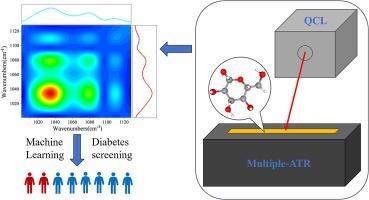Enhancing the accuracy of blood-glucose tests by upgrading FTIR with multiple-reflections, quantum cascade laser, two-dimensional correlation spectroscopy and machine learning
IF 4.3
2区 化学
Q1 SPECTROSCOPY
Spectrochimica Acta Part A: Molecular and Biomolecular Spectroscopy
Pub Date : 2024-11-05
DOI:10.1016/j.saa.2024.125400
引用次数: 0
Abstract
The accuracy of screening diabetes from non-diabetes is drastically enhanced by strategically upgrading the bench-marking infrared spectroscopy technique for non-invasive tests of blood-glucose, both with state-of-the-art instrumentation-retrofits and with intelligent spectral-datamining tools. First, the signal-to-noise performance of FTIR in measuring the spectral features of a glucose solution containing bovine serum albumin is improved by 2–3 times with the common single-pass attenuated total-reflection setup replaced by a multi-passes-reflections setup. Second, replacing the ordinary infrared lamp with a quantum cascade laser further improves the signal-to-noise by 3 times. The performance of the upgraded spectrometer in screening hyperglycemia is gauged by the accuracy of such screens derived from 100 repetitive spectral-measurements per glucose concentration, for 24 glucose concentrations spanning the range of 70–300 mg/dL, a range which covers the blood-glucose contents of all non-diabetic and diabetic human-subjects. Third, intelligent datamining methods are exploited to implement decision trees for screening hyperglycemia. Their decisions are mapped into a confusion matrix and the matrix-elements are used to calculate the accuracy merits of each method. Evidently, the accuracy of the multi-passes-FTIR with the standard principal-components datamining method is 80 %. The adoptions of the quantum cascade laser and two-dimensional correlation spectroscopy datamining technique raises this to 96.3 %. Finally, a novel machine learning method, which comprises three different decision-tree tools to generate trial screening decisions and a “majority-voting” datamining tool to reach a final screening decision, yields the best accuracy of 98.8 % ever reported in the literature.

利用多重反射、量子级联激光、二维相关光谱和机器学习提升傅立叶变换红外光谱,从而提高血糖测试的准确性。
通过对用于无创血糖检测的基准红外光谱技术进行战略性升级,采用最先进的仪器改造和智能光谱数据挖掘工具,大大提高了从非糖尿病中筛查糖尿病的准确性。首先,用多通道反射装置取代普通的单通道衰减全反射装置后,傅立叶变换红外光谱在测量含有牛血清白蛋白的葡萄糖溶液光谱特征时的信噪比性能提高了 2-3 倍。其次,用量子级联激光器取代普通红外灯后,信噪比进一步提高了 3 倍。升级后的光谱仪在筛查高血糖症方面的性能是通过对每种葡萄糖浓度进行 100 次重复光谱测量得出的筛查准确度来衡量的,测量的葡萄糖浓度范围为 70-300 mg/dL,涵盖了所有非糖尿病和糖尿病人体受试者的血糖含量。第三,利用智能数据挖掘方法实施决策树,以筛查高血糖。它们的决策被映射到混淆矩阵中,矩阵元素被用来计算每种方法的准确性。显然,采用标准主成分数据挖掘方法的多通道傅立叶变换红外光谱法的准确率为 80%。采用量子级联激光和二维相关光谱数据挖掘技术后,准确率提高到 96.3%。最后,一种新颖的机器学习方法由三种不同的决策树工具组成,用于生成试验筛选决定,并由一种 "多数投票 "数据挖掘工具得出最终筛选决定。
本文章由计算机程序翻译,如有差异,请以英文原文为准。
求助全文
约1分钟内获得全文
求助全文
来源期刊
CiteScore
8.40
自引率
11.40%
发文量
1364
审稿时长
40 days
期刊介绍:
Spectrochimica Acta, Part A: Molecular and Biomolecular Spectroscopy (SAA) is an interdisciplinary journal which spans from basic to applied aspects of optical spectroscopy in chemistry, medicine, biology, and materials science.
The journal publishes original scientific papers that feature high-quality spectroscopic data and analysis. From the broad range of optical spectroscopies, the emphasis is on electronic, vibrational or rotational spectra of molecules, rather than on spectroscopy based on magnetic moments.
Criteria for publication in SAA are novelty, uniqueness, and outstanding quality. Routine applications of spectroscopic techniques and computational methods are not appropriate.
Topics of particular interest of Spectrochimica Acta Part A include, but are not limited to:
Spectroscopy and dynamics of bioanalytical, biomedical, environmental, and atmospheric sciences,
Novel experimental techniques or instrumentation for molecular spectroscopy,
Novel theoretical and computational methods,
Novel applications in photochemistry and photobiology,
Novel interpretational approaches as well as advances in data analysis based on electronic or vibrational spectroscopy.

 求助内容:
求助内容: 应助结果提醒方式:
应助结果提醒方式:


